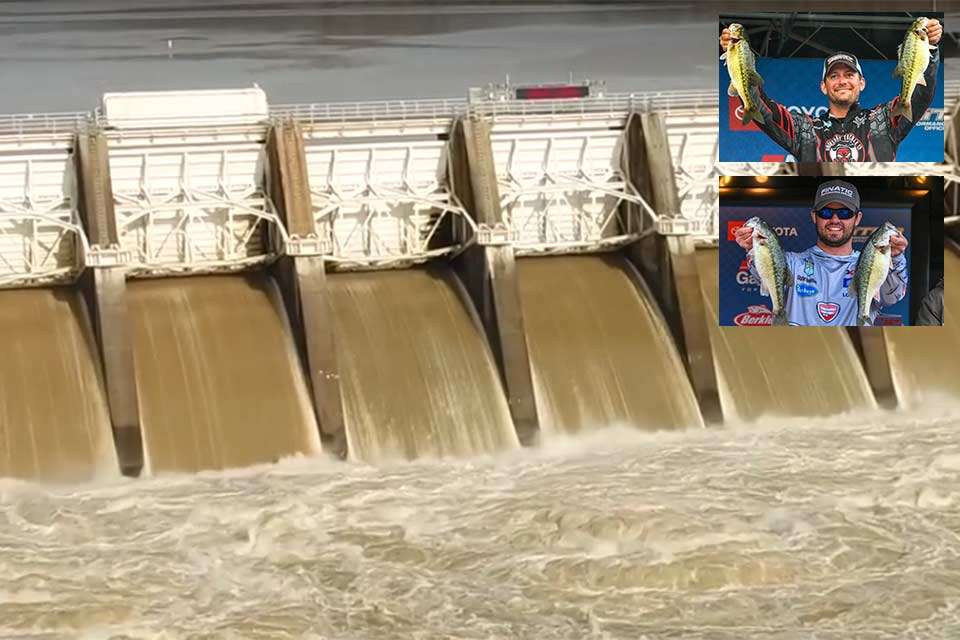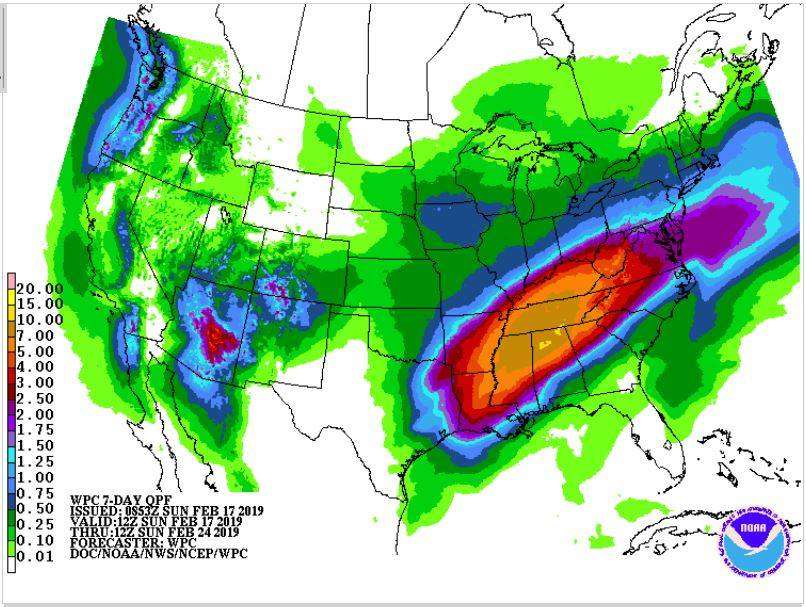
It’s been said of late that if an area is experiencing drought, just schedule a B.A.S.S. event.
When the 2019 GEICO Bassmaster Classic presented by DICK’S Sporting Goods was first announced in April 2018, the region around this year’s site, Knoxville, Tenn., was in moderate drought. Rains later that month might have been a portent of things to come. Recently, 10 inches of rain in 10 days has the Tennessee River system gushing for next week’s championship.
“The lakes above Fort Loudoun are at summer pool,” said Bassmaster Elite angler David Mullins, who lives in Mt. Carmel, Tenn. “Cherokee and Douglass both rose 30 feet. They don’t have much more room to put more water in those lakes. The lakes above them, water’s in the campgrounds and parking lots, so they’re in the process of dumping Cherokee and Douglas as much as they can to alleviate those two lakes upstream.
“And you’ve got more water coming. We had a half inch of rain (Friday) – another half inch coming Sunday. Seven out of 10 days it’s going to be an additional amounts of rain. They’re going to be ripping it. They’ve got to get them down because we usually get more rain this time of year.”
Skylar Hamilton, who lives in Dandridge, Tenn., said the region was swamped by the wettest February, the fourth wettest month ever recorded there.
“I’m probably about 30 minutes from the ramp,” he said. “The easiest road for me to get down there has been closed to flooding. Roads are just now starting to open back up. We had some roads collapse and some other crazy things.”
Although some communities downstream flooded, the Tennessee Valley Authority, which manages 49 dams in the region for hydroelectricity and flood control, proclaimed on their Facebook page that $1.6 billion in flood damages was averted by its timely water generation.
“Douglas and Cherokee are pretty crucial as far as the whole system goes for protecting against flooding,” said Hamilton, who spent three days recently on Douglas. “It’s about as high as I’ve ever seen it for this time of year. The fishing was good, but you couldn’t run anywhere it was so nasty.”
Mullins said the high water on the wooded rivers feeding Douglas and Cherokee has made boating trying, but he doesn’t think the Classic waters will be affected similarly. There’s not as much area for water to collect debris and most of the banks have been cleared out over the years, so he does not expect dangerous conditions, but anglers should remain cautious.
“Douglas and Cherokee look like a forest coming down the river,” he said. “One side to the other as far as you can see, just logs and trash.”
“I’m not sure if Loudoun is going to be that bad, but obviously there’s going to be some obstacles in the water when you’ve got that much high water and current rolling. I don’t see it totally being blown out and awful. I don’t think it’s going to be dangerous conditions, but it’s definitely going to have a lot of color and current.”
Both Hamilton and Mullins agree those conditions will help the fishing. At this time of year, Tennessee River bass want to get out of the current and go shallow, they said.
“They’ll still catch them – they’re the best guys in the world. They’re going to catch if they go to a 3-foot wide stream,” Mullins said.
“If there’s any dingy water at all, it pushes them to the bank,” Hamilton said. “They don’t want to out in the middle of the river in current regardless, but if you put any color into it, they can be in a foot of water, even if it is cold. The warmer it is, the easier they are to catch.”

Hamilton said water coming out of Douglas isn’t usually too muddy, although it’s still dirty. He said opposite conditions make fishing tough on Loudoun.
“I would want it to be what it is now because that place is super tough when it’s clear,” he said. “Clear and hardly any current, that place is horrible. I would want it to be the water conditions they have. I’d want it warmer, because it positions the fish better.”
The weather forecast might be accommodating. After yet another cold snap, temperatures will warm gradually to around 50 before Friday’s first of the three-day practice period, although there is a 100 percent change of rain. It warms to 60 on Saturday when thunderstorms are forecast, and partly cloudy with temps reaching near 70 are predicted for Sunday.
It cools to around 60 the next three days, and there will be showers and high of 66 for Wednesday’s final practice day. There’s more showers on Thursday’s Media Day with a high of 70. It cools for competition days, with morning showers Friday and a high of 58. Saturday and Sunday are have similar forecasts, partly cloudy with lows in the 30s and highs near 50.
“Warms rains would be huge,” Hamilton said. “I call a warm rain anything warmer than the water temperature.
“I would venture it will be a crankbait event, shallow water either flat-sided or squarebill … jigs, and just normal shallow water. Even if we have some cold weather, with water coming through those two dams, it’s hard to influence it.”
Mullins concurs, and he said the conditions actually make the anglers’ approach to fishing simpler as far as how many lures they’ll use.
“For the guy who came and got hours of information the day before it went off limits, I think that’s pretty much out the window now,” he said. “Three or four lures on a deck. I’m thinking a jig, a squarebill and spinnerbait is going to do it. They’ll feed in heavy current in the winter. They like current, and with the water color it’s just going to eliminate a lot more options.”
Both said they believe Loudoun will be the main player, but Tellico could see several anglers attempt to ply its deeper, clearer water. Often, the fish hide out and are difficult to catch from the abundant standing timber, but if there are clouds and wind, it could become a factor.
“It’s going to be how much color is in Tellico River,” Mullins said. “If it’s a lot of color, I don’t know if it’s going to be as good with smallmouth, but I think somebody is going to run over there … if they’re up there biting, then absolutely.”
Hamilton is more doubtful. He’s fished tournaments there starting near the canal that joins Tellico to Loudoun – a good 45-minute run from the Classic takeoff in downtown Knoxville – and he and only a handful of others have gone on the Tellico.
“Somebody is going to have to be really, really on them,” he said. “It’s a possibility, but every local event taking off from canal, honestly only five boats go to Tellico. Even when they’re on the banks spawning, they’re living in that timber, and they’re hard to catch.”
The Tennessee State record largemouth bass was caught in 2015 from Lake Chickamauga, two dams down from Loudoun. The 15-pound, 3-ounce lunker topped the 1954 record by half a pound.
With its success stocking Florida strain largemouth in Chickamauga, the Tennessee Wildlife Resources Agency recently began stocking other TVA lakes, including Loudoun in 2015. While they haven’t grown to record size, lunker bass around 7 pounds are a definite possibility. Last year, a one-day event was won with 27 1/2 pounds.
The TWRA has a 14-inch limit on largemouth while smallmouth must be 18 inches. There will be 52 anglers vying to catch the most weight over three days in the five-fish format. Mullins just wishes he had qualified.
“I’ll be in Section C beside the concession in the bathroom handing out the mints and the hot towels,” he joked. “This is going to be an awesome venue because it’s so centrally located. You can be in New York in a day and Florida in a day. That’s probably the most central located Classic that’s ever been.
“And if you’re going to go to Loudoun, March and April are the best time to go. That’s when the big weights are caught and that’s when that lake shows out.”

